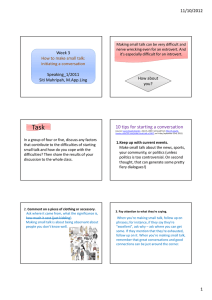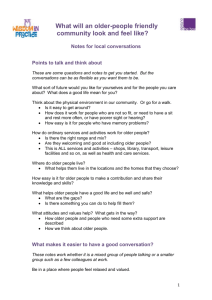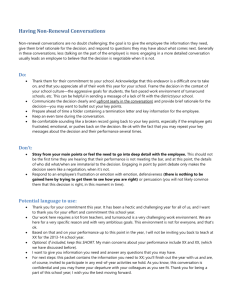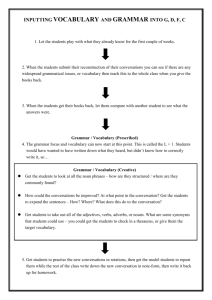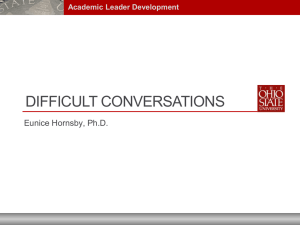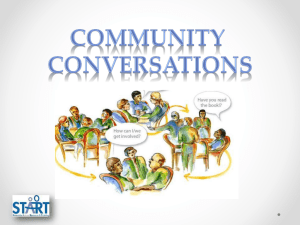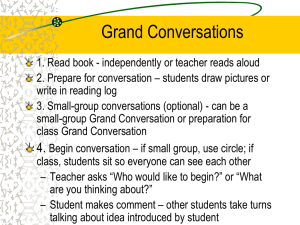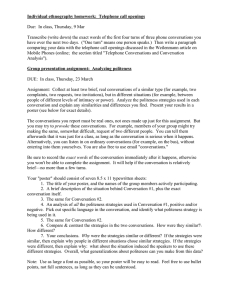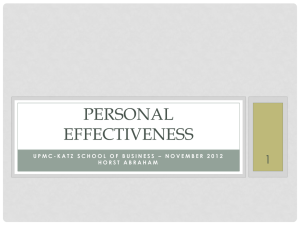Markets are conversations
advertisement
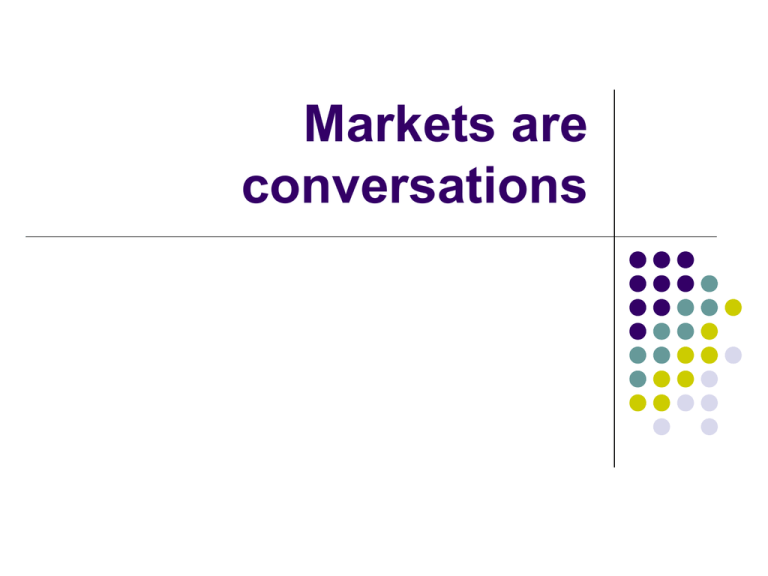
Markets are conversations In the beginning Markets were markets Personal contact Talking Personal examination Personal evaluation Interpersonal haggling You said it as it was Brands were real people: Miller, Skinner, Fisher, Shoemaker, etc The industrial interruption Industrial revolution Enlarges markets beyond the ability of any single vendor to cover it in person Buyers have the opportunity to select from a myriad of sellers found far, far away (catalogue shopping goes all the way to Mr. Sears, 1880s) The bond between seller and buyer was broken More importantly, products became standardized and impersonal workers (assembly line) produced impersonal products A market driven by consumption Needs the product to be pushed to the buyer Needs to convince the buyer that he or she needs THIS product, right NOW Advertising needs to create consumption PR needs to convince the people that this company or product is revolutionary and will change the world as you know it Even if there was no reason to believe such a thing Business is shipping Business became a gigantic assembly line whose business was to ship vast amounts of commodity from producers to consumers Consumers had to accept what was given to them Consumption was guaranteed by the fact that people were offered a limited selection (relatively speaking) One size fits all and ready to wear products invented… The master metaphor was the “channel” through which stuff (merchandise, messages) would be pushed to the people Markets become massified People are turned from talkative browsers at the country fair into consumers aggregated in abstract “markets” A market ceases to be a place, becomes a statistical fact A number of customers sufficiently large to justify producing a specific commodity Market participants are assumed to be the same, their needs to be satisfied the same Examples Automobile: Ford, model T Cereal: Kellogg Gasoline: Standard Oil Telephone: ATT Radio: NBC-CBS duopoly Communication in mass markets Is essentially mass communication One to many To very, very, very, many A single message is BROADCAST to many Mass audiences evolved Newspaper (penny press) Radio (first national media in the US) Television (first truly global medium) Markets during the industrial era Are turned from a noun, into a verb Marketing is something we DO TO people We “market” products to people, or people to advertisers Marketing Is not a service, it is an interruption of our natural train of thought or conversations It is anti-conversation In the last few decades marketing has become something we just don’t want to hear about anymore Attempts to fix the problem Disguise marketing as something else: Entertainment Information Even education In fact marketing is war Against you… How did the Internet change things? It has created marketplaces where consumers, erstwhile isolated, can get in touch with each other Ebay, Amazon, Epinion, Rotten tomatoes review sites Support groups Product fan groups (MAC) Sport afficionados The Internet is a bazaar… “The Net is a real place where people can go to learn, to talk to each other, and to do business together. It is a bazaar where customers look for wares, vendors spread goods for display, and people gather around topics that interest them. It is a conversation. At last and again. “ Where everybody knows your name In this new place, every product you can name, from fashion to office supplies, can be discussed, argued over, researched, and bought as part of a vast conversation among the people interested in it. "I’m in the market for a new computer," someone says, and she’s off to the Dell site. But she probably won’t buy that cool new laptop right away. She’ll ask around first -- on Web pages, on newsgroups, via email: "What do you think? Is this a good one? Has anybody checked it out? What’s the real battery life? How’s their customer support? Recommendations? Horror stories?" Markets are conversations about The value and utility of products Firm and brand reputations Tips and tricks related to using products How to roll your own Conversation take the shape of Bulletin board postings Blogs Wikis Review sites Or simple ym or email exchanges Value produced by Internet Can be measured in terms of amount of conversation it generates N^2*C/N = Number of members squared multiplied by the amount of conversation per head Variation of metcalfe’s law=value of network is equal to the square of its members Internet markets Do not push They allow YOU to pull They enable YOU to pull information and value from what you find on the web Internet conversations are not only About people talking Or reviewing It can be broadly conceived as people interacting for Software writing (Linux, Apache) Knowledge indexing (Wikipedia) Innovation (Nine sigma, innocentive) Marketing/retail – Astore, Cafepress PR: blogging, news rating, social bookmarking PR in the era of conversations Does not mean Public relations It is PRIVATE relations You should talk to people as individuals You should treat each person with respect Do not talk to, talk with them Because… They are in the business of making and spreading messages just as much as you are… PR should not be BS Dishonest Canned Preset Best PR people are not In the business of intoxicating or even informing the public But in the business of Striking conversations with people and their media… This does not mean That PR (or marketing) is less But MORE important Than ever It should however be conducted in a decent, human way Advertising Needs to be radically different Not banners, or links or words Needs to be a message that is vetted by happy customers who help you spread the word Word-of-web is what sells the product Marketing communication You might think Marketing Communications departments talk about communications. Not really. They actually spend most of their days thinking about how to hide what’s really going on in the organization. That’s what crafting "messages" is mostly about. For every "message," there are dozens or hundreds of facts -- interesting, useful facts -- that never get said. Numbers that change. Divisions that move. Features added and subtracted. And that’s not counting all the outright negative stuff: the merger that failed, the layoffs, the departed leaders, the stopgap products. What to do Put your message on the web as fast as you can and Loosen up. Lighten up. Listen for a while. Have a voice, speak real words, not TechnoLatin Share fact and tips Accept failure and work with clients to get over it Replace brochures with real people from your organization talking to real consumers Compete not by lowering price, but by adding value to your products through honesty and conversation (support) Or by allowing the customer to co-brand things with you In brief, allow for mass personalization and mass customization The Pentium debacle What does it highlight? What is the point of the story? Marketing is a craft What’s happening to the market is precisely what should -- and will -- happen to marketing. Marketing needs to become a craft. Recall that craftworkers listen to the material they’re forming, shaping the pot to the feel of the clay, designing the house to fit with and even reveal the landscape. The stuff of marketing is the market itself. Marketing can’t become a craft until it can hear the new -- the old -sound of its markets. By listening, marketing will re-learn how to talk.
